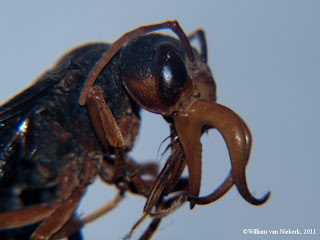If we're being complete about it, there's a subgenus and a subspecies as well (because after nearly a year of failure, I wrote to an entomologist with a published interest in the genus. That doesn't usually work. That's just how awesome Synagris wasps are. People write back), so I'll expand it to:
Synagris (Synagris) proserpina nyassae
(although I don't know who gave it the subspecific name, which is why Gribodo 1981 remains in pride of place in the title)
The specific epithet is the name of the roman goddess of spring (wiki tells you more, here), although the origins of the word is from the latin "to emerge", proserpere.
The generic (and subgeneric) seems to be from the latin agrum, meaning field, and the greek συν ("syn"), or with/together (As far as I'm aware, the same root prefix for "Sympathy" and so forth).
If we were to take this on face value to make up a "common" name for the subspecies, we'd go with Malawi Proserpina's (or emergent) True Field Associated Wasp. We'd probably tone that down to Malawi Proserpina's Field Wasp.
Alternatively, I could just reveal that the genus Synagris is often referred to as "Tusk(ed) wasps". for a reason which I can reveal quite simply with an image of a male specimen:
(I apologise for interrupting your day with an image of a deceased insect, but it may help to know that it was found dead rather than killed, in an area thronging with females, and so probably died happy. Very happy)
In case you're having trouble working it out, it has long, curved tusks springing from the base of its (also quite long) mandibles.
So, today's special guest might be best described as a Malawi Proserpina's (or emergent) Tusked Wasp.
We're going to talk about behaviour, now.
Some of you may have been told that insects are simple creatures which basically lay their eggs and leave them (I was first told this by a secondary school biology teacher. However, she was a young earth creationist, so her misgivings about insects aren't her major disqualification there).
The wasps (which includes the bees and ants, by the way), are the most stunning illustration of this not being true. While some - notably the parasitoid Ichneumons, and many of the herbivorous sawflies - have no contact with their young after meticulously selecting a suitable host/foodplant, several lineages have evolved complex social organisations and even the most complex invertebrate communication system known entirely for the purpose of raising the next generation.
Potter wasps in the subfamily Eumeninae are not truly social, unlike the paper wasps of the Vespinae and Polistinae, but do, as individuals, go to impressive lengths to provide for their undeveloped offspring. In most cases, this simply involves finding a suitable site, building an elaborate structure to keep the elements off the soon-to-be larva, preparing a suitable meal and sealing the egg in with it.
As if doing this for each and every egg they lay is not enough work for an animal less than an inch long and with only a year or two to live, Synagris (and several other groups) go further. They don't seal the pot, which has usually been built on a sturdy blade of grass, high enough to be overlooked by roving ants and similar ground predators, but not so high as to attract the attention of birds, but instead keep it open and, every day until the larva pupates, they find food, mash it up, and give it to their larva. When they're not doing this, they sit on top of the nest, ready to chase away any parasitoid wasps or flies that would otherwise harm their young. They also try - with some success - to chase away birds and mammals (including humans) that get too close. And I've heard of them unsuccessfully trying to chase away a tractor.
So now, before I lament that this group isn't better studied, conserved and loved (people shouldn't drive tractors at them), on with the show:
Eukaryota
Animalia
Eumetazoa
Nephrozoa
Bilateralia
Protostomia
Arthropoda
Hexapoda
Insecta
Dicondylia
Pterygota
Metapterygota
Neoptera
Eumetabola
Endopterygota
Hymenopterida
Hymenoptera
Apocrita
Aculeata
Vespoidea
Vespidae
Eumeninae
Synagris
Synagris (Synagris)
Synagris (Synagris) proserpina
Synagris (Synagris) proserpina nyassae.
That's all, folks.
Acknowledgements. Identified as probably belonging to Synagris by me, confirmation of genus and species through Dr. Rob Longair, of the University of Calgary.
.JPG)

No comments:
Post a Comment